A sound social media listening practice is essential to every brand or business. It can help with reputation management, brand health, customer service, SEO, and market research.
Most importantly, it helps brands truly understand and connect with their audiences and customers. We’d go as far as saying that a good social listening practice is the key ingredient in having happy customers and an engaged audience.
Ever wonder how you develop a winning product or service? By giving your customers what they want or need, of course.
And how can you find out what your audience wants and needs? Two words: Social Listening.
Table of Contents
- What is Social Listening?
- What’s the difference between Social Listening vs. Social Monitoring?
- Importance of Social Listening
- Benefit 1: Use Social listening to develop an informed roadmap
- Benefit 2: Use Social Listening to gather competitor intel
- Benefit 3: Social listening to understand your consumer better
- Benefit 4: Social listening to find inspiration for new content
- Benefit 5: Social listening to manage crisis and maintain your reputation
- Benefit 6: Social listening to find influencers and brand ambassadors
- Benefit 7: Social listening for lead generation
- Benefit 8: Social listening to improve SEO
- 5 Steps to create a social listening strategy
- Top Social Listening Tools
- People talking about you, are you listening?
What is Social Listening?
Social listening is the process of monitoring online conversations and turning them into powerful insights that drive your business strategy. The key word here is “insights”, which are attained from online conversations. Social media listening consists in identifying and analyzing social media activity around the topic of interest.
For instance, every modern business, regardless of its size, needs to know what existing and ideal customers say about:
- their brand
- their product or service
- their campaigns
- specific keywords and topics
- their competition
What’s the difference between Social Listening vs. Social Monitoring?
The main difference between social listening & social media monitoring is that Social Listening focuses on those conversations outside of your control (user-generated, competitors’, industry leaders and product-related content). On the other hand, Social Media Monitoring focuses on tracking and analyzing how audiences respond to your content.
Unlike social media monitoring, social listening helps brands understand not only what your audience talks about online, but also the “why” behind all those conversations.
Here are some differences between the two:
- Social media monitoring is a daily activity that focuses on individual social media mentions, while social listening is a strategic process that focuses on identifying patterns and trends.
- Social media monitoring is the process of tracking and collecting the data – and social listening is the process of analyzing the data and extracting the meaning from it.
- Social media monitoring is reactive – it’s about monitoring conversations and reacting to comments, complaints, or praise in a timely manner. Social listening on the other hand is proactive. Its end goal is to provide businesses with audience insights that can help companies develop a more informed strategy.

In other words, social media monitoring is the first step in the social listening process. The figures and statistics gathered through monitoring of online channels help in noticing patterns and identifying gaps in your content.
However, social listening as an inhibitive part of digital adoption and goes a step further and turns the raw data into insights that you can use to spot opportunities to develop and grow your business. It can help consolidate your position in existing markets, expand into new verticals, or improve customer care and grow your brand loyalty.
Importance of Social Listening
To succeed in the modern business landscape, companies have to adopt a customer-centric strategy. Being customer-centric (or customer-driven) simply means getting closer to your customer in order to understand what they need and expect from your brand.
Knowing and delivering exactly what your customer wants is the best possible user experience.

Social listening helps you understand what gets your customers out of bed in the morning and what keeps them up at night.
It gives you insight into their expectations, the challenges they face every day, and their biggest pain points. It shows you what you do right, as well as if there are some areas where you could improve.
It also gives you a clear understanding of your competitors: why customers buy from them, what they don’t do so well, and what gaps you can exploit.
Next, we’ll go through some of the benefits of an effective social listening strategy. This will give you a better understanding of how you can operationalize social listening within your organization.
Benefit 1: Use Social listening to develop an informed roadmap
Great products solve real customer problems. And social listening can give you detailed insights into what those problems are.
Start by asking yourself: What do your customers expect and need from your product or service? What are some features that could make their experience better?
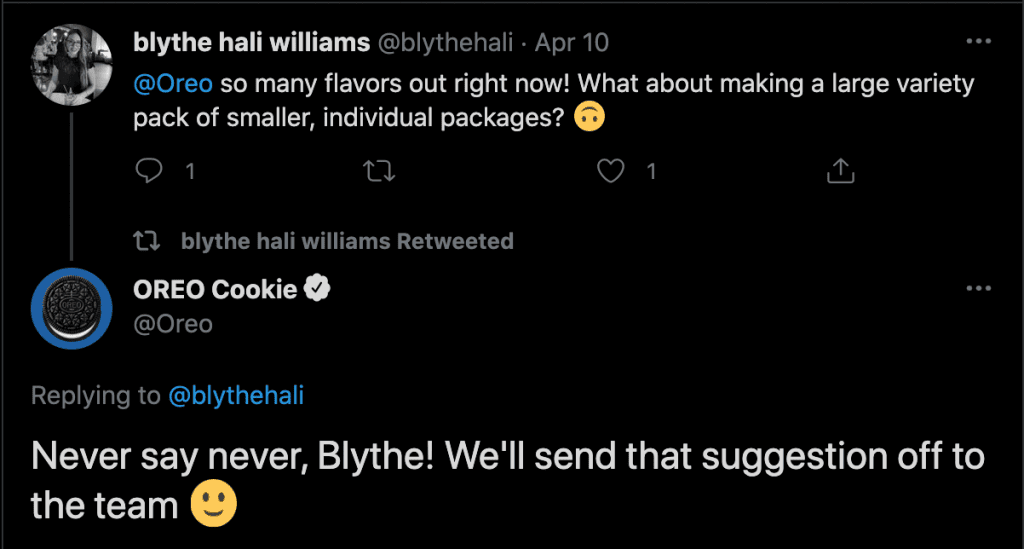
For example, if you notice customers praising your customer support and care online – you can use industry-leading support as one of the differentiators that separate you from your competitors.
However, you might also notice that people mention that there is a high learning curve and they need additional support during setup.
You can use this information to organize additional group training sessions around specific features or workflows. In the long term, you can create a more intuitive experience with onboarding checklist within your product with in-app guidance, an online help center, and so on.
Then, you might use this feedback and introduce new integrations or add features that are currently missing.
Benefit 2: Use Social Listening to gather competitor intel
Great brands keep tabs on their competitors.
The more you know about your competitors’ positioning, reputation, upcoming launches, and so on, the easier it will be to differentiate your brand, exploit gaps and adopt best practices.
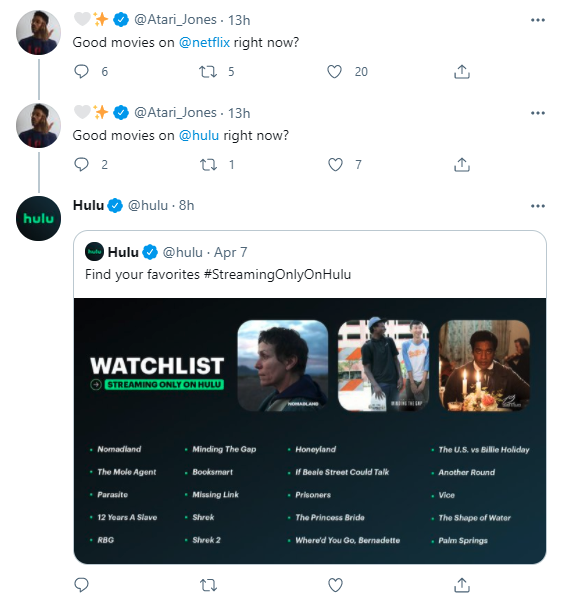
Social listening helps you keep tabs on your competitors and stay in the know about the features they’re developing, their brand sentiment, online reputation, things that are working well for your audience, as well as new channels and formats they’re exploring.
Benefit 3: Social listening to understand your consumer better
Your ideal customers share their challenges, ask for advice, and help each other online. Monitor online conversations to learn what are the pain points of your audience.
Then use this knowledge to develop solutions to these problems, or craft marketing messaging that resonates and inspires action.
Benefit 4: Social listening to find inspiration for new content
We already mentioned you can use your ideal customers’ own words to describe their needs and your solution.
Social listening also helps you track trending topics and conversations that can serve as inspiration for your next evergreen and topical content pieces.
Benefit 5: Social listening to manage crisis and maintain your reputation
Being online and being seen comes with many risks – including bad reviews, unsatisfied clients, or even unfair competition against your business.
Social listening helps you identify potential crisis events and handle them before they escalate and hurt your business.

Benefit 6: Social listening to find influencers and brand ambassadors
Social listening can help you surface influential individuals among people engaging in conversations around topics and keywords related to your niche. In fact, these influencers may already use your product, or they could be opinion leaders who are well-known and respected in your industry.
Also, social listening can surface when influencers or celebrities are mentioning your product or following your accounts. Even if there isn’t a potential partnership in sight, you can still benefit from this unintentional endorsement.
Either way, social listening makes it easy to find the right-fit influencers for different campaigns or successfully launch a brand ambassador program.
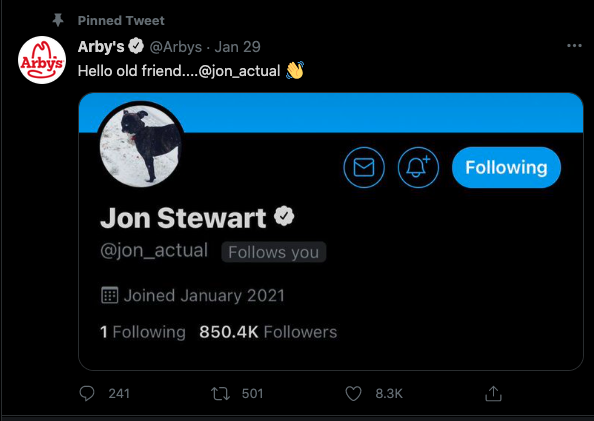
Benefit 7: Social listening for lead generation
Did you know that there is someone at this moment who is already looking for a product like yours?
Social listening will help you find customers at the consideration and purchase stages.
Many are already on social media asking their peers for recommendations and using social listening can help you sell or engage in an informed manner.
Benefit 8: Social listening to improve SEO
We already mentioned how social listening can help you determine exactly which keywords your audience is using to find your products, which should inform your content strategy. Using your audience’s own language and terms can have a huge impact on your SEO.
Also, social listening can help you find link-less mentions as well mention opportunities to build links to your website, which will impact your SEO.
Keeping an eye on the most influential voices in your industry or niche can also surface opportunities for guest-posting, and co-marketing opportunities which will increase your website traffic.
By now, it’s clear that the question isn’t whether you should use social listening to power up your business, but how you can create a social listening strategy that delivers value across all departments in your organization.
Here are 5 steps to kick off a successful social listening strategy and prove value fast:
The first step is deciding who will be in charge of building and scaling your social listening strategy.
Making sure there’s someone that owns this as a project is crucial, as it will ensure you dedicate time and resources to social listening within your organization.
Once you allocate the responsibilities and know who will own your social listening strategy – you need to decide what goals you’d like social listening to support.
As we already mentioned, a robust social media listening strategy can help you achieve multiple benefits. Depending on who owns the project, you may decide to support different departments and goals. Some of these can include:
- Product development
- Product marketing and sales
- Demand generation
- Customer success or customer service
- HR
- PR
If you’re just getting started with social listening, it would be wise to pick only one or two main goals and stakeholders across the organization. Once you’ve proven value and learned what works for your teams, you can scale your social listening strategy.
To create a social listening strategy that’s scalable and proves value fast, you need to pick a social listening tool. Manual topic monitoring and analysis is nearly impossible due to the high amount of conversations that happen online every day. Unless you operate in a very small niche, tracking all conversations across social media platforms, indexing, and analyzing them would be incredibly difficult. Here are some things to consider when selecting a social listening tool:
- Social platforms you want to track
- Social listening goals and metrics to track them
- Automated solutions: tracking, reporting, alerts, etc.
- ROI
There are plenty of tools to choose from – we’ve listed a few in the next section.
Step 3: Pick your topics and top-priority platforms
Next, you need to pick the right keywords, as well as the social media platforms you’ll monitor. To do this you need to know your audience and the platforms they use. Be as specific as possible when picking your topic to get highly relevant insights.
It’s worth noting that you probably won’t pick the best topics right off the bat. Just like with any other new initiative, you need to get started, gather some initial data, review performance, and refine your topics as the data comes in.
And even the topics you initially pick give you great results, make sure you keep refining your strategy and testing different keywords and topics to find the most relevant conversations for your brand.
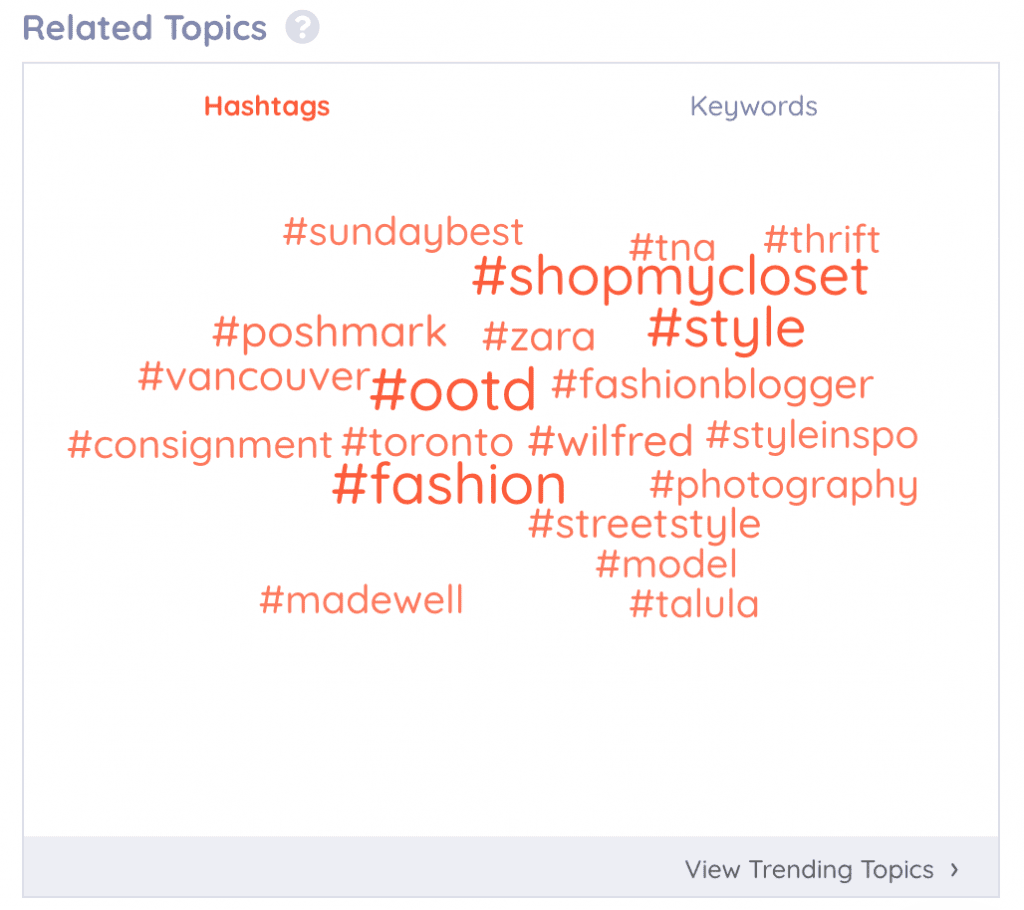
Step 4: Establish your analytics process
At this point, you’ve laid the groundwork: you know what tool you’ll use, what topics you’ll track, what goals you’ll support, and you’ve established ownership.
Next, you need to establish your analytics and social reporting process.
Decide what you’ll report, how frequently and who needs to be kept in the loop. This will depend on the goals you’ve decided to support with social listening.
Then, make a decision about what will be the primary means of communication: you may decide to send weekly reports to key stakeholders, set up monthly meetings for review of insights, or include social listening insights in departmental meetings.
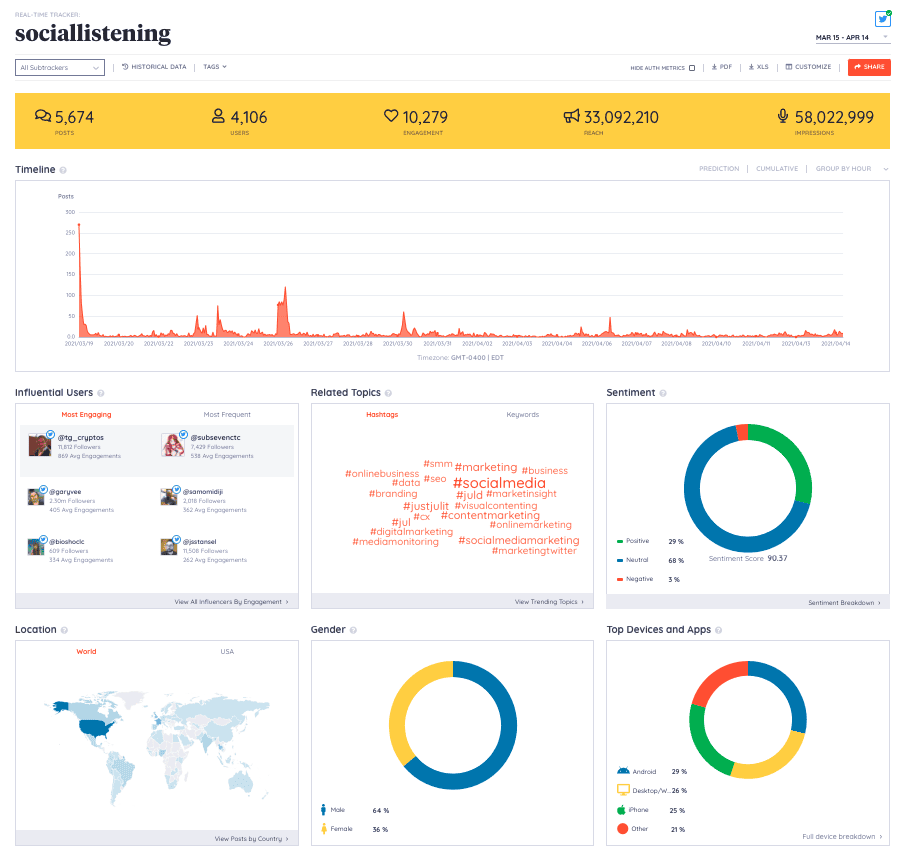
Step 5: Get started
If you followed the first four steps, you’ll have a fully working social listening function that’s linked to specific goals and stakeholders.
As mentioned, your initial framework won’t be your final framework.
Over time, you’ll notice areas of inefficiency and will improve your strategy. You’ll get additional people involved, expand the topics you monitor, and create an efficient process to derive insights and plan the next steps.
But to be able to improve, first, you need to get started.
Top Social Listening Tools
1. Keyhole
Keyhole is a social listening and social media analytics platform trusted by brands like H&M, Mashable, Google, and Alibaba to name a few. It tracks conversations on social channels like Twitter and Instagram, as well as blogs, forums, and news sites.
With Keyhole, you’re able to track relevant topics and conversations online using keywords and hashtags with a boolean search. You can also, monitor accounts from competitors, influencers, and industry leaders.

On top of that, with Keyhole’s unlimited publishing and scheduling features, you can manage your activities across different channels from a single platform.
Apart from looking at your performance in isolation, Keyhole also allows you to keep tabs on your competitors. It’s easy to compare your social media performance with that of competitors with group tracking for real-time benchmarking.
Finally, Keyhole allows you to look at your own historical data, and make predictions on trends based on AI insights.
Price: Starting at $79 / month
2. Google Alerts
If you’re just starting out and want to dip your toes into social listening before you make an investment, you can try Google Alerts.
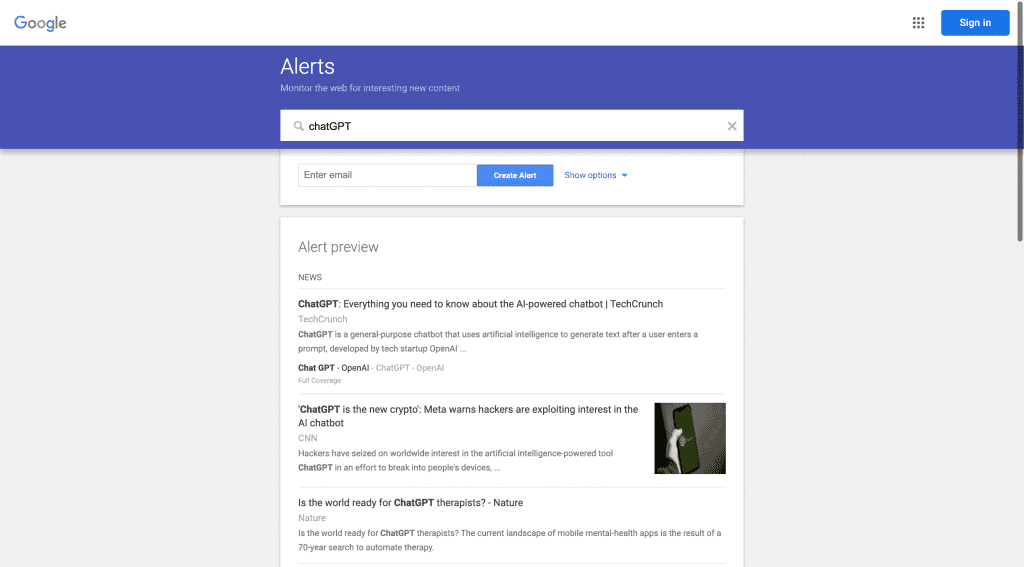
As its name suggests, Google Alerts allows you to set up alerts for specific keywords and get notified when the keyword you’ve chosen gets mentioned online. Google Alerts supports different languages.
It’s important to note that Google Alerts doesn’t offer advanced features and insights, and it’s more of a social media monitoring than a social listening tool. However, it’s completely free and easy to use, so it is definitely worth trying.
Having some monitoring tool in place is better than not knowing anything about important online conversations after all!
Price: Free
3. Hootsuite
Social media management software Hootsuite also offers social listening capabilities.

You can use Hootsuite to track mentions and listen to relevant conversations – as well as segment conversations related to paid and owned media.
Also, Hootsuite measures and compares your social media performance against that of competitors.
A big drawback is the price, as the social listening features are included in higher-tiered packages only.
Price: Business plans start at $599 per month
4. Awario
Awario is a web monitoring tool that crawls 13 billion pages every day to get important data about your audience. These insights include a number of mentions, sentiment analysis, top influencers across different channels, and status/progress analytics.
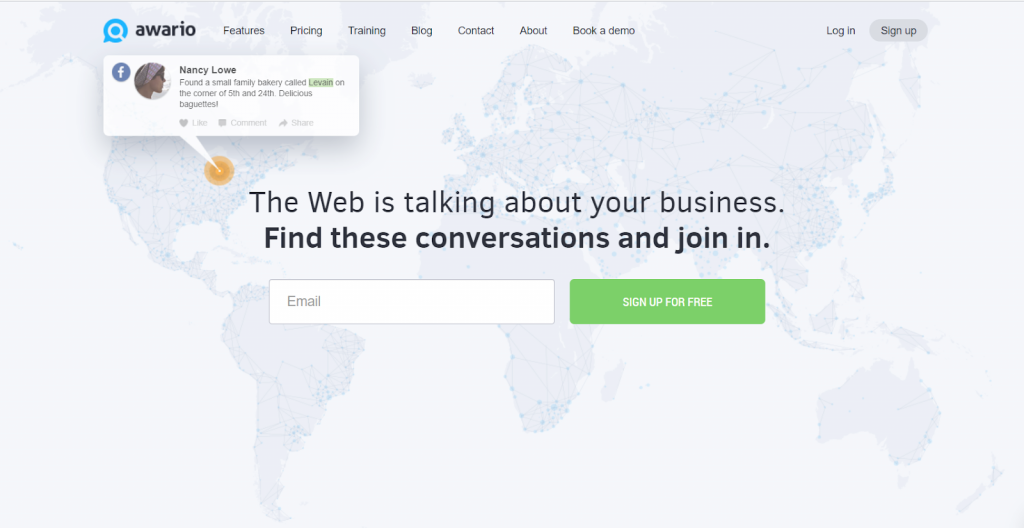
It also offers a social media customer service that lets you be there right when your customers need your help.
Providing you with an intelligent alert system, the tool lets you know as soon as an important conversation starts gaining traction.
This helps you prioritize customer support initiatives based on the impact they can have on your business.
Awario is great for monitoring brand mentions and keeping track of online conversations. And it makes it possible to track unlinked brand mentions all over the web.
However, users report a steep learning curve. Also, the price can escalate quickly.
Price: Not provided.
People talking about you, are you listening?
Your audience is talking all the time. They’re having conversations about things they need, challenges they’re facing day-to-day, as well their opinions on particular topics. They give each other advice and review your product, as well as your competitors’ products.
By tuning in to these conversations, you’ll be able to get invaluable insight into customer sentiment and issues they need to solve.
You’ll also be able to spot opportunities as they arise and generate ideas about content, product development and improvement, customer support initiatives, and so on.
Social listening tools like Keyhole help you streamline social media management and derive insights from data quickly. Keyhole includes campaign tracking, influencer marketing, social listening as well as social scheduling capabilities – all in a single platform.
Our customers report that Keyhole saves them 5 hours a week on gathering and reporting data, which translates into over $7,000 saved every year.
See for yourself – start your zero-obligation free trial today and see how Keyhole can help you make data-driven decisions and work smarter.